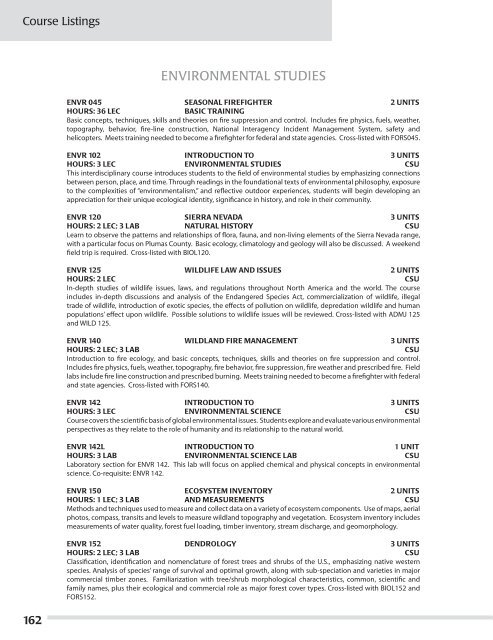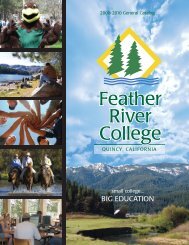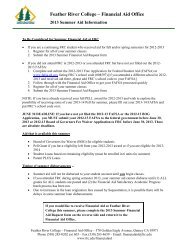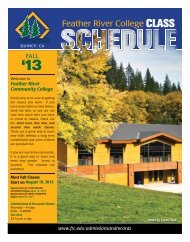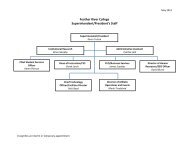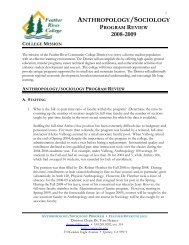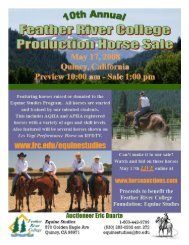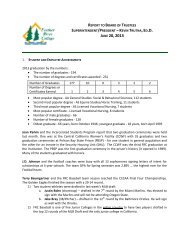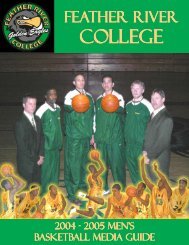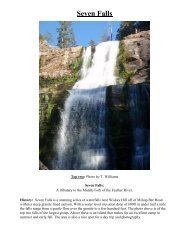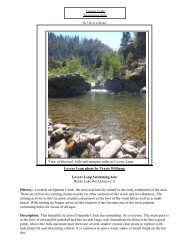2012 Catalog PDF - Feather River College
2012 Catalog PDF - Feather River College
2012 Catalog PDF - Feather River College
You also want an ePaper? Increase the reach of your titles
YUMPU automatically turns print PDFs into web optimized ePapers that Google loves.
Course Listings<br />
ENVIRONMENTAL STUDIES<br />
ENVR 045 SEASONAL FIREFIGHTER 2 UNITS<br />
HOURS: 36 LEC<br />
BASIC TRAINING<br />
Basic concepts, techniques, skills and theories on fire suppression and control. Includes fire physics, fuels, weather,<br />
topography, behavior, fire-line construction, National Interagency Incident Management System, safety and<br />
helicopters. Meets training needed to become a firefighter for federal and state agencies. Cross-listed with FORS045.<br />
ENVR 102 INTRODucTION TO 3 UNITS<br />
HOURS: 3 LEC ENVIRONMENTAL STUDIES CSU<br />
This interdisciplinary course introduces students to the field of environmental studies by emphasizing connections<br />
between person, place, and time. Through readings in the foundational texts of environmental philosophy, exposure<br />
to the complexities of “environmentalism,” and reflective outdoor experiences, students will begin developing an<br />
appreciation for their unique ecological identity, significance in history, and role in their community.<br />
ENVR 120 SIERRA NEVADA 3 UNITS<br />
HOURS: 2 LEC; 3 LAB NATURAL HISTORY CSU<br />
Learn to observe the patterns and relationships of flora, fauna, and non-living elements of the Sierra Nevada range,<br />
with a particular focus on Plumas County. Basic ecology, climatology and geology will also be discussed. A weekend<br />
field trip is required. Cross-listed with BIOL120.<br />
ENVR 125 WILDLIFE LAW AND ISSUES 2 UNITS<br />
HOURS: 2 LEC<br />
CSU<br />
In-depth studies of wildlife issues, laws, and regulations throughout North America and the world. The course<br />
includes in-depth discussions and analysis of the Endangered Species Act, commercialization of wildlife, illegal<br />
trade of wildlife, introduction of exotic species, the effects of pollution on wildlife, depredation wildlife and human<br />
populations’ effect upon wildlife. Possible solutions to wildlife issues will be reviewed. Cross-listed with ADMJ 125<br />
and WILD 125.<br />
ENVR 140 WILDLAND FIRE MANAGEMENT 3 UNITS<br />
HOURS: 2 LEC; 3 LAB<br />
CSU<br />
Introduction to fire ecology, and basic concepts, techniques, skills and theories on fire suppression and control.<br />
Includes fire physics, fuels, weather, topography, fire behavior, fire suppression, fire weather and prescribed fire. Field<br />
labs include fire line construction and prescribed burning. Meets training needed to become a firefighter with federal<br />
and state agencies. Cross-listed with FORS140.<br />
ENVR 142 INTRODucTION TO 3 UNITS<br />
HOURS: 3 LEC ENVIRONMENTAL SCIENCE CSU<br />
Course covers the scientific basis of global environmental issues. Students explore and evaluate various environmental<br />
perspectives as they relate to the role of humanity and its relationship to the natural world.<br />
ENVR 142L INTRODuCTION TO 1 UNIT<br />
HOURS: 3 LAB ENVIRONMENTAL SCIENCE LAB CSU<br />
Laboratory section for ENVR 142. This lab will focus on applied chemical and physical concepts in environmental<br />
science. Co-requisite: ENVR 142.<br />
ENVR 150 ECOSYSTEM INVENTORY 2 UNITS<br />
HOURS: 1 LEC; 3 LAB AND MEASUREMENTs CSU<br />
Methods and techniques used to measure and collect data on a variety of ecosystem components. Use of maps, aerial<br />
photos, compass, transits and levels to measure wildland topography and vegetation. Ecosystem inventory includes<br />
measurements of water quality, forest fuel loading, timber inventory, stream discharge, and geomorphology.<br />
ENVR 152 DENDROLOGY 3 UNITS<br />
HOURS: 2 LEC; 3 LAB<br />
CSU<br />
Classification, identification and nomenclature of forest trees and shrubs of the U.S., emphasizing native western<br />
species. Analysis of species’ range of survival and optimal growth, along with sub-speciation and varieties in major<br />
commercial timber zones. Familiarization with tree/shrub morphological characteristics, common, scientific and<br />
family names, plus their ecological and commercial role as major forest cover types. Cross-listed with BIOL152 and<br />
FORS152.<br />
162


